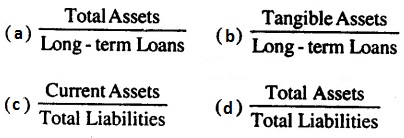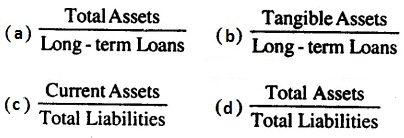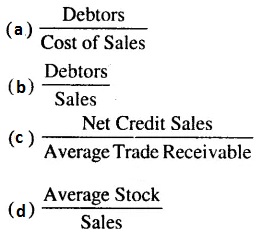CBSE Class 12 Accountancy – MCQ and Online Tests – Unit 10 – Accounting Ratios
Every year CBSE conducts board exams for 12th standard. These exams are very competitive to all the students. So our website provides online tests for all the 12th subjects. These tests are also very effective and useful for those who preparing for competitive exams like NEET, JEE, CA etc. It can boost their preparation level and confidence level by attempting these chapter wise online tests.
These online tests are based on latest CBSE Class 12 syllabus. While attempting these our students can identify the weak lessons and continuously practice those lessons for attaining high marks. It also helps to revise the NCERT textbooks thoroughly.
CBSE Class 12 Accountancy – MCQ and Online Tests – Unit 10 – Accounting Ratios
Question 1.
The gross profit ratio is the ratio of gross profit to :
(a) Net Cash Sales
(b) Net Credit Sales
(c) Closing Stock
(d) Net Total Sales
Answer
Answer: (d) Net Total Sales
Question 2.
Which one of the following ratios is most important in determining the long-term solvency of a company ?
(a) Profitability Ratio
(b) Debt-Equity Ratio
(c) Stock Turnover Ratio
(d) Current Ratio
Answer
Answer: (b) Debt-Equity Ratio
Question 3.
Liquidity Ratio:
Answer
Answer: (c)
Question 4.
The ratios are primarily measures of earning capacity of the business.
(a) Liquidity
(b) Activity
(c) Debt
(d) Profitability
Answer
Answer: (d) Profitability
Question 5.
Total Assets ₹ 8,10,000
Total Liabilities ₹ 2,60,000
Current Liabilities ₹ 40,000
Debt-equity ratio is:
(a) 0.05 : 1
(b) 0.4 : 1
(c) 2.5 : 1
(d) 4 : 1
Answer
Answer: (c) 2.5 : 1
Question 6.
Total Assets ₹ 7,70,000
Total Liabilities ₹ 2,60,000
Current Liabilities ₹ 40,000
Total Assets to Debt Ratio is:
(a) 3.5 : 1
(b) 2.56 : 1
(c) 2.8 : 1
(d) 3 : 1
Answer
Answer: (a) 3.5 : 1
Question 7.
Operating Ratio is:
(a) Profitability Ratio
(b) Activity Ratio
(c) Solvency Ratio
(d) None of these
Answer
Answer: (a) Profitability Ratio
Question 8.
The formula for ascertaining Total Assets to Debt Ratio is:
Answer
Answer: (a)
Question 9.
Which of the following is an operating’ income ?
(a) Sale of Merchandise
(b) Interest Income
(c) Dividend Income
(d) Profit on the sale of old car
Answer
Answer: (a) Sale of Merchandise
Question 10.
Which of the following non-operating expense?
(a) Rent
(b) Selling Expenses
(c) Wages
(d) Loss on Sale of Machinery
Answer
Answer: (d) Loss on Sale of Machinery
Question 11.
Current Ratio includes:
(a) Stock
(b) Debtors
(c) Cash
(d) All of these
Answer
Answer: (c) Cash
Question 12.
Proprietory ratio is calculated by the following formula:
Answer
Answer: (c)
Question 13.
The following groups of ratios primarily measure risk
(a) Liquidity, activity and profitability
(b) Liquidity, activity and common stock
(c) Liquidity, activity and debt
(d) Activity, debt and profitability
Answer
Answer: (d) Activity, debt and profitability
Question 14.
To know the return on investment, by capital employed we mean:
(a) Net Fixed Assets
(b) Current Asset-Current Liabilities
(c) Gross Block
(d) Fixed Assets + Current Assets-Current Liabilities
Answer
Answer: (d) Fixed Assets + Current Assets-Current Liabilities
Question 15.
The term fixed assets include :
(a) Cash
(b) Machinery
(c) Debtors
(d) Prepaid Expenses
Answer
Answer: (b) Machinery
Question 16.
If sales is 7 4,20,000 sales returns is 7 20,000 and cost of goods sold 7 3,20,000 gross profit ratio will be :
(a) 20%
(b) 25%
(c) 15%
(d) 10%
Answer
Answer: (a) 20%
Question 17.
Ratio based on figures of profit & loss as well a the Balance sheet are:
(a) Profitability Ratios
(b) Operation Ratio
(c) Liquidity Ratio
(d) Composite Ratio
Answer
Answer: (d) Composite Ratio
Question 18.
Equity share capital ₹ 15,00,000
Reserve and Surplus ₹ 7,50,000
Total Assets ₹ 45,00,000
Properletory Ratio ?
(a) 50%
(b) 33.3%
(c) 200%
(d) 60%
Answer
Answer: (a) 50%
Question 19.
Debtors Turnover Ratio :
Answer
Answer: (c)
Question 20.
When opening stock is ₹ 50,000 closing stock ₹ 60,000 and cost of goods sold is ₹ 2,20,000, then stock turn over ratio is:
(a) 2 times
(b) 3 times
(c) 4 times
(d) 5 times
Answer
Answer: (a) 2 times
Question 21.
What does Creditors Turnover Ratio take into account:
(a) Total credit purchases
(b) Total credit sales
(c) Total cash sales
(d) Total cash purchases
Answer
Answer: (a) Total credit purchases
Question 22.
Cost of goods sold :
(a) Sales – Net profit
(b) Sales – Gross profit
(c) Purchases – Opening Stock
(d) None of the above
Answer
Answer: (b) Sales – Gross profit
Question 23.
Proprietory Ratio indicates the relationship between proprietor’s funds and….
(a) Reserve
(b) Share Capital
(c) Total Assets
(d) Debentures
Answer
Answer: (c) Total Assets
Question 24.
The term‘Current Assets’include
(a) Long-term Investment
(b) Short-term Investment
(c) Furniture
(d) Preliminary Expenses
Answer
Answer: (b) Short-term Investment
Question 25.
The ideal liquid ratio is :
(a) 2 : 1
(b) 1 : 1
(c) 5 : 1
(d) 4 : 1
Answer
Answer: (b) 1 : 1
Question 26.
Profitability Ratios are generally expressed in :
(a) Simple Ratio
(b) Percentage
(c) Times
(d) None of these
Answer
Answer: (b) Percentage
Question 27.
Operating Ratio is:
(a) Profitability Ratio
(b) Activity Ratio
(c) Solvency Ratio
(d) None of these
Answer
Answer: (a) Profitability Ratio
Question 28.
Stock turnover ratio comes under :
(a) Liquidity Ratio
(b) Profitability Ratio
(c) Activity Ratio
(d) None of these
Answer
Answer: (c) Activity Ratio
Question 29.
The satisfactory ratio between internal and external equity is. :
(a) 1 : 2
(b) 2 : 1
(c) 3 : 1
(d) 4 : 1
Answer
Answer: (b) 2 : 1
Question 30.
Current Ratio =
(a) Current Assets/Current Liabilities
(b) Liquid Assets/Current Liabilities
(c) Liquid Assets/Current Assets
(d) Fixed Assets/Current Assets
Answer
Answer: (a) Current Assets/Current Liabilities
Question 31.
Liquid Assets include :
(a) Bills Receivable
(b) Debtors
(c) Cash Balance
(d) All of these
Answer
Answer: (d) All of these
Question 32.
The ideal current ratio is :
(a) 2 : 1
(b) 1 : 2
(c) 3 : 2
(d) 3 : 4
Answer
Answer: (a) 2 : 1
Question 33.
Which of the following assets is not taken into consideration in calculating acid-test ratio ?
(a) Cash
(b) Bills Receivable
(c) Stock
(d) None of these
Answer
Answer: (c) Stock
Question 34.
The two basic measures of liquidity are :
(a) Inventory Turnover and Current Ratio
(b) Current Ratio and Liquid Ratio
(c) Current Ratio and Average Collection Period
(d) Current Ratio and Debtors Turnover Ratio
Answer
Answer: (b) Current Ratio and Liquid Ratio
Question 35.
Liquid Ratio is also known as:
(a) Current Ratio
(b) Quick Ratio
(c) Capital Ratio
(d) None of these
Answer
Answer: (b) Quick Ratio
Question 36.
To test the liquidity of a concern which of the following ratios is useful ?
(a) Capital Turnover Ratio
(b) Acid Test Ratio
(c) Stock Turnover Ratio
(d) Net Profit Ratio
Answer
Answer: (b) Acid Test Ratio
Question 37.
Profitability Ratio is generally shown in :
(a) Simple Ratio
(b) Percentage
(c) Times
(d) None of these
Answer
Answer: (b) Percentage
Question 38.
When Cash is 7 10,000 Stock is 7 25,000, B/R is 7 5,000 Creditors is 7 22,000 and Bank Overdraft is 7 8,000 then current ratio is :
(a) 2 : 1
(b) 4 : 3
(c) 3 : 4
(d) 1 : 2
Answer
Answer: (b) 4 : 3
Question 39.
The term ‘Current Liabilities’ does not include: .
(a) Sundry Creditors
(b) Debentures
(c) Bills Payable
(d) Outstanding Expenses
Answer
Answer: (b) Debentures














0 Comments:
Post a Comment